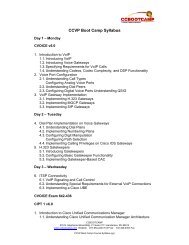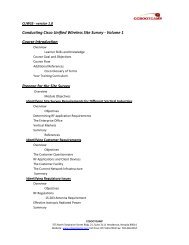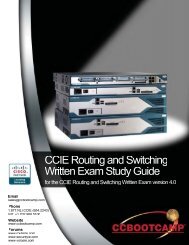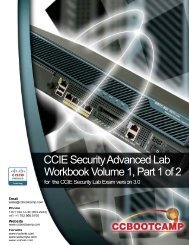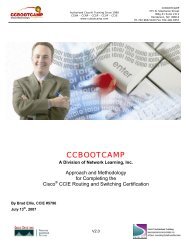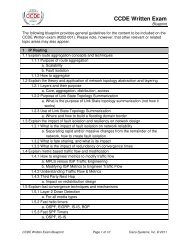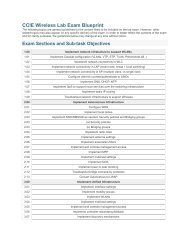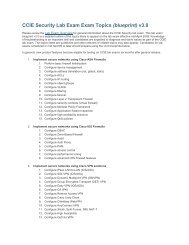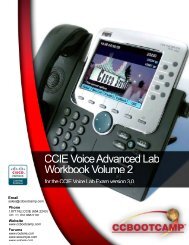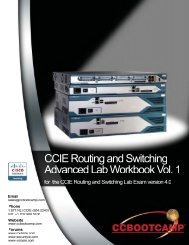CCIE Wireless Written Exam Blueprint
Cisco CCIE Wireless Written Exam Blueprint. - CCBootcamp
Cisco CCIE Wireless Written Exam Blueprint. - CCBootcamp
- No tags were found...
You also want an ePaper? Increase the reach of your titles
YUMPU automatically turns print PDFs into web optimized ePapers that Google loves.
<strong>CCIE</strong> <strong>Wireless</strong> <strong>Written</strong> <strong>Exam</strong> <strong>Blueprint</strong>The comprehensive <strong>CCIE</strong> <strong>Wireless</strong> written exam (#350-050) has 100 multiple-choice questions and is two hours induration. The topic areas listed are general guidelines for the type of content that is likely to appear on the exam.Please note, however, that other relevant or related topic areas may also appear.<strong>Exam</strong> Sections and Sub-task Objectives1.00 Plan WLAN installations √1.01 Define standards-based WLAN (802.11x standards)1.02 Define WLAN organizations and regulations1.03 Identify customer requirements for the wireless LAN1.04 Translate customer requirements into services and design recommendations1.05 Determine WLAN security policies and constraints1.06 Identify ambiguity and/or information gaps1.07 Evaluate environmental characteristics1.08 Define the tasks/goals for a preliminary site survey1.09 Modify proposed solutions based on the applicable regulations1.10 Evaluate the existing L2/L3 network infrastructure1.11 Conduct the site survey2.00 Design WLAN installations2.01 Determine AP quantity and placement based upon the site survey and customer requirements, includesAP type and antenna type2.02 Recommend autonomous or unified deployment model and design2.03 Identify the wireless features needed to be implemented in the design, including AP groups, L2/L3roaming, H-REAP, VoWLAN, AAA override, etc.2.04 Design the wireless topology including VLANs, DHCP, SSIDs, IP addressing, mobility groups, etc.2.05 Draft an RF operational model that includes:(a) Radio resource management (Auto-RF, manual, hybrid, TPC and DCA)(b) Channel use (Radar, other non-WiFi interference)(c) Power level, overlap2.06 Draft WLAN Security policies:(a) Traffic restrictions for L2 filters (802.11 association filters), L3/L4 filters (ACL)(b) Per user, per interface, per SSID; Management access restrictions; peer-to-peer blocking(c) Layer 2/3 security(d) WPS, MFP, NAC2.07 Specify the server infrastructure needed to provide the required services2.08 Determine the feasibility of carrying LWAPP over WAN2.09 Determine hardware and software provisioning requirements for the supporting network infrastructure2.10 Determine client provisioning given client hardware and software requirements2.11 Use wireless network design tools
2.12 Draft a design that includes deliverables such as: detailed or high level annotated topology diagram,internal estimates for each site, BOMs for a wireless LAN3.00 Implement WLAN Installations3.01 Implement the WLAN in stages including priming and system testing access points3.02 Set appropriate configuration parameters3.03 Configure the existing infrastructure applications to support the WLAN, including authentication services(Radius, TACACS+, CA), NTP, DHCP, DNS (LWAPP controller), clients3.04 Configure the existing network infrastructure to support the WLAN, including VLANS, Multicast, QoS,routing, switch port configurations, port access through Firewalls (guest access, anchor controllers), etc.3.05 For an autonomous wireless architecture deploy APs and antennas, <strong>Wireless</strong> Distribution Systems(WDS),3.06 Bridges (Point-to-Point, Point-to-Multi-Point), Work-group bridges3.07 For a unified wireless architecture deploy APs and antennas, WLC with(out) WCS, AP and WLCconfigurations (auto-provisioning), location (location server, WCS Maps, location calibration)3.08 Implement WLAN Security policies, including:(a) Traffic restrictions:(i) L2 filters (802.11 association filters)(ii) L3/L4 filters (ACL) - per user, per interface, per SSID(iii) Management access restrictions(iv) Peer-to-peer blocking(b) Layer 2/3 security(c) WPS,MFP3.09 Implement support Voice over WLAN deployments, for both Unified and Autonomous3.10 Verify WLAN operation, Client, Location, Voice, Roaming, Post deployment site survey, Network HighAvailability, Auto-RF, etc4.00 Operate WLAN installations4.01 Determine key performance indicators (kpi) baseline WLAN operational characteristics4.02 Collect baseline WLAN operational characteristics using network analysis tools4.03 Establish fault management policy and procedures for indicators that should be routinely monitoredincluding Establish Alert Profiles; Noise, Channel Utilization, Interference, Load, etc.4.04 Monitor for faults(a) Actively monitor changes based on thresholds (proactive); SNMP polling(b) Receive alarms and wait until notification. (reactive); SNMP traps, syslog messages, WCSnotifications4.05 Monitor performance trends including Capacity planning; Error rates, Number of clients associated withan AP, AP loading, Threshold figures (1% packet loss for Voice), reference 802.11t; End-to-end trafficflows, etc.4.06 Monitor WLAN Security policies.(a) Traffic restrictions:(i) L2 filters (802.11 association filters)
(ii) L3/L4 filters (ACL) - per user, per interface, per SSID(iii) Management access restrictions(iv) Peer-to-peer blocking(b) Layer 2/3 security(c) WPS4.07 Monitor RF environments using Cisco Spectrum Expert; AP infrastructures4.08 Correlate events, alarms and alerts5.00 Troubleshoot WLAN issues5.01 Use the standard troubleshooting method to solve problems5.02 Check , validate and analyze:(a) Client Devices(i) Interpret and analyze client side logs.(ii) Validate client connectivity/troubleshoot client via WCS.(iii) Interpret and analyze wireless traces.(iv) Client wireless drivers and supplicant software.(a) Network infrastructure.(i) Check and validate current channel/power settings(ii) Validate security events with WCS(iii) Validate location information in WCS(iv) Validate trap generation, notifications in WCS(v) Collect appropriate logs for analysis to isolate the problem.(vi) Interpret and analyze sniffer traces5.03 Analyze the collected information on the RF environment using client-side information and AP-sideinformation (through WLC or WCS) and spectrum analyzer (Cisco Spectrum Expert).5.04 Audit voice over WLAN deployment5.05 Verify baseline functionality has been restored upon implementing problem resolution




